This is a reading response to Andrew Blauvelt’s article “Towards Relational Design” that was posted to Design Observer in 2008. Our class had some trouble wrapping our heads around it. This response is a bit fragmented and super expository but works through my developing understanding of the concept of relational design.
+ + + + + + + + +
“We are in the midst of a much larger paradigm shift across all design disciplines, one that is…potentially more transformative than previous isms, or micro-historic trends, would indicate.”
Andrew Blauvelt posits that we are currently undergoing a slow, massive shift in all fields of design toward solutions that are relational and contextually based. He claims that this is modern design’s third major phase, following phases of formal innovation (the first) and the creative development of meaning (the second). I appreciate his ability to see patterns so large in fields so often disparate.
How might graphic design play a role here?
I have thought a lot about the connections between Graphic Design and relation or engagement since I began taking classes in Art and Social Practice with Harrell Fletcher. Taken on a whim, my first term in the class proved so transformative that I repeated the class twice after that. I was unfamiliar with the concept of Social Practice as defined by Fletcher, and even with the framework of contemporary art. To me, art was paintings. In a museum. Maybe art could be photography. In a gallery. But the insights, theories and approaches I learned through Social Practice began to permeate my thinking and encroach into my evolving concept of Graphic Design.
Social Practice is essentially about engagement.
It brings relational and contextual aspects into its formulation and execution. A Social Practice art piece could be a performance, a repeated action, an interaction, an exchange, an investigation or an immersive experience. Social Practice art requires people, and it requires experience. Social Practice artists may adapt or mimic practices or structures found in everyday life, and it is in this seemingly non-art context that interesting truths, stories and experiences emerge.
Graphic Design is essentially about communication. And communication is engagement. Graphic Design relies on an audience. It relies on people and everyday life, though Graphic Design need not attempt to mimic “real life” because it simply is real life.
I early on began to sense the connections between Graphic Design and Social Practice, but could never seem to articulate them. One relied heavily on objects, physical formats, and end-products. The other shunned the art object and instead advocated intangible ends–or perhaps no ends at all, and instead just the process.
But both hold the capacity for–and in fact require–engagement.
Why this round-about comparison of Social Practice Art and Relational Design? Because the development of a new wave of Design is supported and mirrored by a shift in experimental art practice. They reinforce one another.
That Blauvelt uses Daniel Eatock’s work as an example of relational (in this case, participatory) design thrills me. I find Daniel Eatock to an apt example of an effective marriage of form, meaning and engagement. Call me a fan if you will, but I consistently appreciate the work that Eatock makes: whether he requests user input for “Picture of the Week,” creates form layouts that beg for participation, or develops a web template that encourages the indexing of projects and the sharing of process, Daniel Eatock considers the experience and engagement of his audience and empowers would-be designers through an open-ended process.
I see Blauvelt’s example of the shift of architecture toward the relational to be equally applicable to graphic design:
“In architecture, the discourse has shifted from the purity and organizational control of space to the inhabitation of real places–the messy realities of actual lives, living patterns over time…and social, not simply physical, sites.”
This statement, when paired with Blauvelt’s discussion of new contexts for user-input within design, offers a glimpse into the state of graphic design today. Web 2.0 and the social networks fueled by developments in technology facilitate user-input and interactive design on a whole new level.
Models like Threadless or the print-on-demand realm that Blauvelt mentions offer graphic design new contexts. These formats require participation. They include non-designers in design practice, therefore democratizing design and forming it into a populace process. (I could write forever about Threadless.) These formats reflect a type of “social logic” that is indicative of the new wave of design and far different from formal logic or the logic of meaning we see in design history.
I recently read an article called “Better than Free.” The author, Kevin Kelly, proposes that modern consumers, in a world of frequent reproduction, want things that cannot be copied. Consumers will open their wallets for: Immediacy, Personalization, Interpretation, Authenticity, Accessibility, Embodiment, Patronage and Findability. It isn’t a perfect article, and some of these things need to be explained, but what I took away from this is: consumerism is changing, and by default graphic design must change. The Threadless model is so distinctly a “21st-century brand” because it offers immediacy, personalization, accessibility, (etc., etc.) and ENGAGEMENT.
I saw Jelly Helm speak in September on the topic of “What’s next?” He blew my mind with the concept of “21st-century brands,” also known as “people-powered brands” or “emergent brands.” He must have read Blauvelt’s article as research for that lecture. Emergent brands enable the user to create content and meaning by using that brand. They allow themselves to be adopted into the identity of their users. Apple. Wikipedia. Google. These are emergent brands. They’re not rigid. They allow for individuality within the brand, for consumers to participate and tout the brand as their own. These brands become adopted by users and integrated into personal identities. “I’m an Apple person.” “I googled it.” Graphic design is by some accounts the business of branding, and this idea of emergent brands offers a glimpse of what graphic design might look like in the next century as we continue down our path of relational design.
Back to Blauvelt. He nabbed my undying attention with his opening question and kept me fascinated until the end of the article. He is simultaneously objective and optimistic. How does he do it? My favorite tidbit is in the second-to-last paragraph:
“…the third phase presents a multitude of contingent or conditional solutions: open-ended rather than closed systems; real world constraints and contexts over idealized utopias…in lieu of the forlorn designer, the possibility of many designers…the ascendency of enabling or generative systems; the end of discrete objects, hermetic meanings, and the beginning of connected ecologies.”
This is exciting.
THIS PLACE PROJECTS WEB CONTENT
October 29, 2009
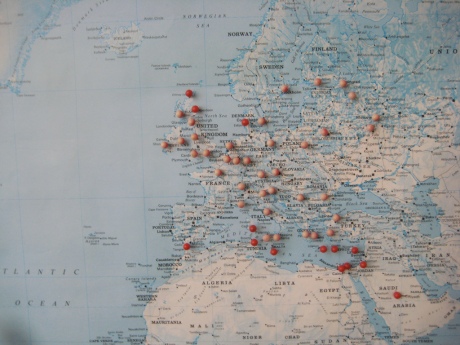
A site map: another thing that was due today.
WHAT DOES THIS PLACE PROJECTS LOOK LIKE ON THE INTERNET?
Three sections.
Frequently updated content that promotes and unites projects and facilitates discussion.
• Artists, projects, books, writers, photographers, events, organizations, record labels, imprints.
• Interviews, reviews, comparisons.
• Photographic exploration of places. (TPP exclusives) (myself, my community, artists I approach,
• News: grants, new project releases, promotional for events and releases.
• Call for entries: collaborative zine? Whole, independent projects?
• Exhibition for This Place Projects projects.
• Documentation of the project: photographed objects, photographed events.
SECTION THREE: Navigation/Information/About
• About This Place Projects
• List of This Place Projects artists and their relevant links.
• Blog bios, guest bloggers.
• Store to purchase releases
WORDPRESS THEMES
October 27, 2009
I definitely didn’t find exactly what I wanted to find, but there are WordPress themes out there that almost fit my high expectations! Here are a few that I’m considering. These were all found on Best WordPress Themes. Many are considered “magazine” style themes. I think I might need to take Art 342.
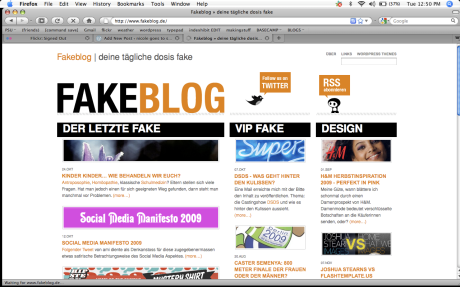 Top of the list. Would have to kill the orange if possible. Allows for categories.
Top of the list. Would have to kill the orange if possible. Allows for categories.
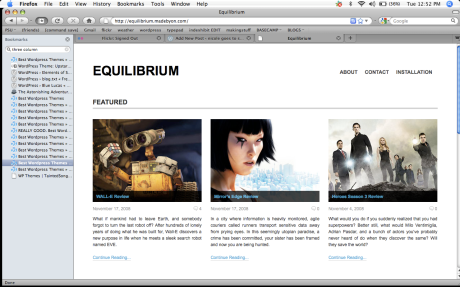 Another top contender. I like that it allows the images to be the main content, but there might be some trouble with navigation and people wanting to zip through posts like a regular blog.
Another top contender. I like that it allows the images to be the main content, but there might be some trouble with navigation and people wanting to zip through posts like a regular blog.
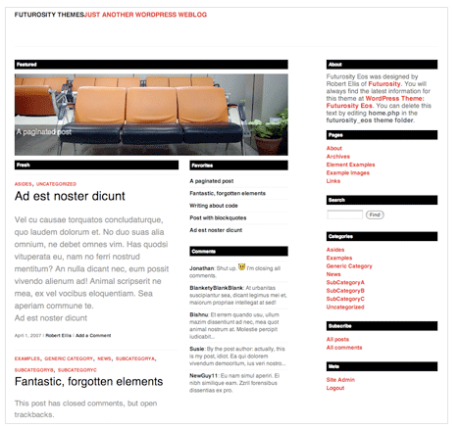 This is closest to what I had in mind, though it might be frustrating to have a whole column of navigation that I don’t have control over. (far right) I like that this has a place for a featured image. Futurosity Eos.
This is closest to what I had in mind, though it might be frustrating to have a whole column of navigation that I don’t have control over. (far right) I like that this has a place for a featured image. Futurosity Eos.
Term Long/Thesis Project
October 8, 2009
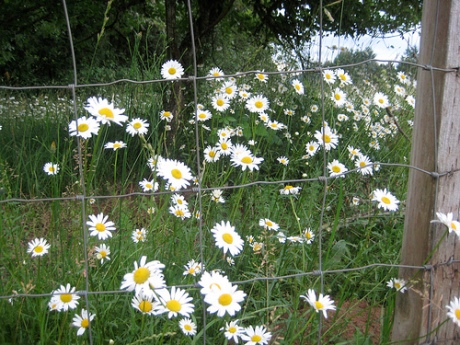 Dexter, Oregon, a rural community in the southern Willamette Valley. A place I’ve been thinking about, spending time in, and exploring.
Dexter, Oregon, a rural community in the southern Willamette Valley. A place I’ve been thinking about, spending time in, and exploring.
This summer I stepped back and took inventory of the kind of work I was making and the projects I was interested in. I thought about the books I was reading, the best experiences I’d had, the trips I’ve taken, the things I daydream about, the movies I enjoyed, the most impactful classes I’ve taken.
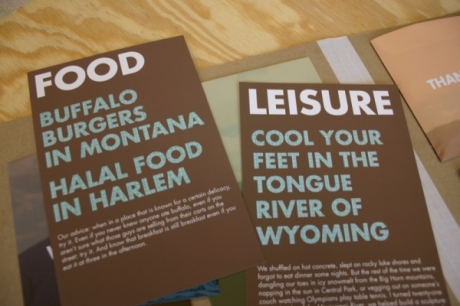 Get Out, Art 320 Termlong Project, one of my first projects about a place: America.
Get Out, Art 320 Termlong Project, one of my first projects about a place: America.
Was there a reoccurring theme that tied all of these things together? What was it?
Place.
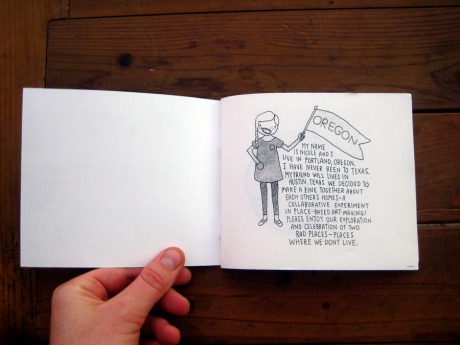 Where We Don’t Live, This Place Projects Release #2, Collaboration with Will Bryant
Where We Don’t Live, This Place Projects Release #2, Collaboration with Will Bryant
One of those impactful classes was Geography of Environment and Society. For the first time since fifth grade, I learned the names of every country on the planet. I also learned the concepts of space and place. A space is a measurable location, an area, an expanse that can be pinpointed, defined. It’s tangible and objective. A place, on the other hand, is a space that has been injected with meaning and experience. It’s a location whose definition takes into consideration context, point of view, personal relationships. A place has heart and a place has history.
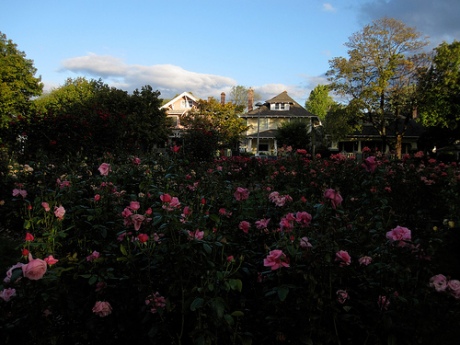 Ladd’s Addition, the neighborhood in which I now live. A place with a rich history, an interesting community of Portlanders to think about.
Ladd’s Addition, the neighborhood in which I now live. A place with a rich history, an interesting community of Portlanders to think about.
So I made up my mind to start something. Something general enough to encompass my own creative endeavors. Something open enough to facilitate curatorial and collaborative projects with other artists. Something to release products, to hold events, to lend legitimacy and structure to my musings and exploration of place.
Right now it’s just a blog. Here is an excerpt from the “ABOUT THIS PLACE” page.
“THIS PLACE is an experiment in creating and curating location-based projects. THIS PLACE is an independent press. THIS PLACE is a record label. THIS PLACE is a party. THIS PLACE is a gallery, a store, a museum, a website, a brand and an organization. THIS PLACE is an idea. THIS PLACE is an investigation. THIS PLACE is a celebration of here, of there, of spaces that have been infused with meaning and experience to become places.
Through networking, sponsorship and exposure, This Place seeks to highlight, host, and unite place-based projects of all media.”
So, that’s what I want to work on this term. The logo is stupid. I want to fix that. I want to clarify how people can participate. I want to develop a website that makes it easy to join forces, experience the releases, and follow my research on place. I “released” two zines (here and here) through This Place Projects this summer, but it hasn’t been clearly structured so they sort of slipped through the cracks.
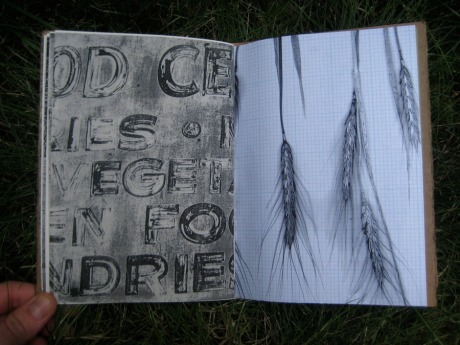 An Ode to Summer in the West, This Place Projects Release #1
An Ode to Summer in the West, This Place Projects Release #1
I need to BRAND the enterprise more fully. I need an identity, a press kit. A defined idea that I can refer to for structure.
I want to release more projects from other artists.
I want to hold events relating to projects.
I want to keep a regular blog highlighting the work of others.
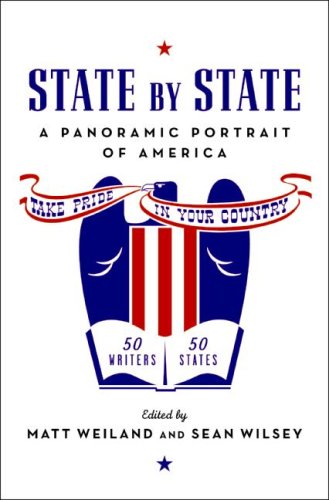 State by State, a book I read this year about all fifty states in America. An example of a project I’d want to review, write an essay on, post to This Place Projects.
State by State, a book I read this year about all fifty states in America. An example of a project I’d want to review, write an essay on, post to This Place Projects.
It’s kind of funny where this all came from. I attended an art opening/lecture Mike Perry gave at the Grass Hut this summer. He had a selection of prints up and was talking about two book projects he edited: Hand Job, on handmade typography, and Over and Over, on drawing patterns. Someone asked him, “How did you go about getting a book deal from Princeton Architectural Press?” His answer was: “I pitched a ton of ideas to them, and they chose this one.” I thought to myself, “If I could edit a book project about any topic, what would it be about?” Now this idea feels bigger than a book, it feels more fluid and inclusive and scaleable and alive. It’s just interesting to think of corralling all of your crazy ideas, thoughts and interests into a comprehensive topic.
Any thoughts?
ANYWHERE BUT HERE
October 4, 2009
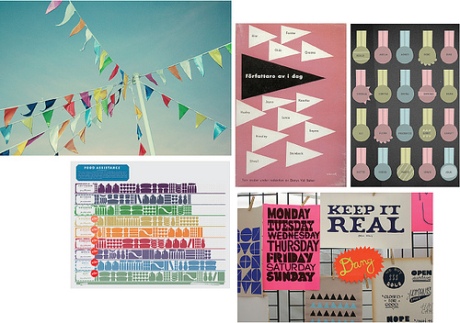
A sampling of mood boards to come. Find our gallery here.
Project: Anywhere But Here
Group: Christy, Orion, Nicole
Premise: To encourage our peers and others in the PSU community to contemplate beyond the present. To encourage community and discussion among participants. To create awesome, mind-blowing design work that is functional, meaningful and beautiful.
Format:
Pose the question: Where would you rather be right now? Hold a workshop where participants can explore that question by making a flag of their response. (Responses could include: “Home” “Florida” “1969” “At a Backstreet Boys Concert in 1999” “In Harry Potter’s Castle” “In Stefan Sagmeister’s studio”)
Document the workshop. Post it to a website.
Deliverables:
Promotional posters, fliers.
Blank flags.
Travel journal/pocket notebook/passport to elsewhere
Ticket to elsewhere
Cookies shaped like flags.
Problems: How can we make the experience meaningful for participants?
How can we make the documentation represent the feeling of the experience?
How can we produce deliverables that are more than useless ephemera? Meaningful keepsakes, symbolic sculptures?
Christy will have more in-depth writing about our plan on her blog.
HARRELL FLETCHER
October 1, 2009
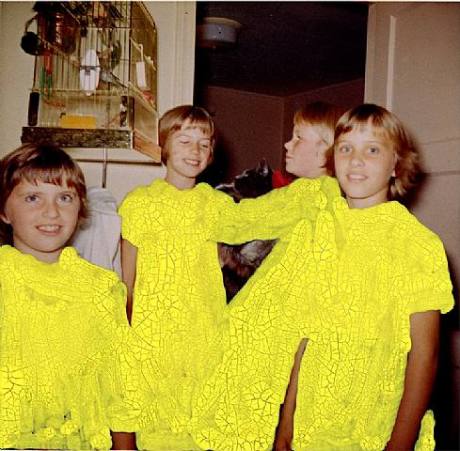
Untitled (Four Girls) Harrell Fletcher, 2005
***I read the Allan McCollum interview with Harrell Fletcher on Bombsite.com***
People, context, audience
Social Practice, at its base, is about people. It’s investigative journalism reinterpreted. It’s about, and for, the regular person. It elevates, if only temporarily, the average citizen to the status of artist, collaborator or celebrity.
It’s hard to talk about Social Practice without talking about Harrell Fletcher. It seems that this brand of socially engaged art falls wholly into his realm. I always find it hard to explain what Social Practice is to anyone without using Harrell’s projects as examples.
By placing the mundane in an art context, it is immediately elevated to a place of interest. An audience is created for content which before had no audience. This is one part of Harrell Fletcher’s social practice. The other part is a total subversion of that same art world in which, by purpose or default, Harrell Fletcher’s artworks are placed. He often works outside of the restrictions of a traditional art context and make his works more accessible to “regular people.” A non-art audience.
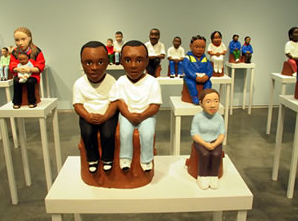
Lawn Sculptures, Harrell Fletcher, 2002
Take this project, for example. A residents of a NE Portland neighborhood were photographed and transformed into lawn sculptures after Harrell happened into a conversation with a homeowner about her vandalized lawn sculptures. This art project was born out of a happenstance conversation, and in the end brought together a community to share in artwork about their neighbors and neighborhood. The ceramic sculptures were shown at PICA and then made into cement sculptures that reside in the front yard of the Williams family in Portland. Artwork about and for regular people. Regular people experiencing artwork both inside and outside of a traditional setting. A non-art audience.
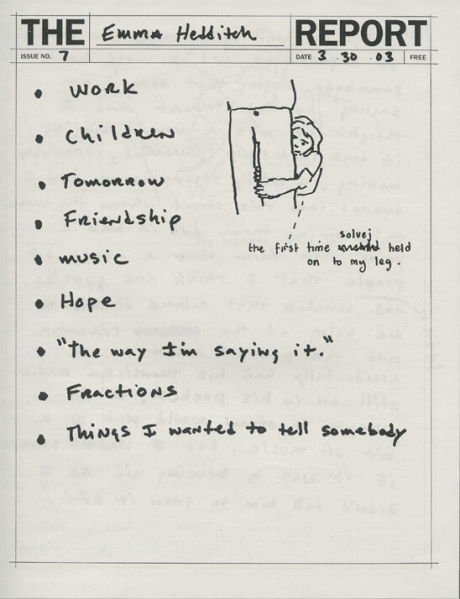
The Report, Harrell Fletcher, 2003
Another project, The Report, is based on the premise that regular people are interested in learning regular facts about other regular people. Harrell conducted hour-long interview/conversations with people he knew, on topics of their choice, and produced one-page reports about them. Downloadable on his website, Harrell says, “I’ll give them a chance to identify what they want to talk about, how they’d like to represent themselves, and I’ll put it out there in a way that both regular people and the art world can have access to them.” The project proves what many of Harrell’s projects prove: that given the proper context and presentation, no one is regular and conversation isn’t boring.
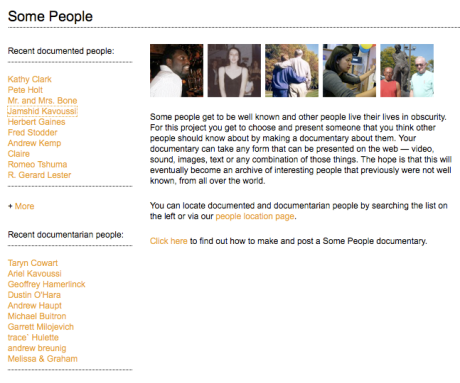
Some People, Harrell Fletcher, 2008. http://www.somepeoplepeople.com
Some People is another of Harrell’s projects that encourages the exchange of personal information among regular people like you and me. It’s a website on which anyone can post a documentary about anyone else. It allows ordinary people to be elevated to the status of celebrity, of art, and celebrates their daily lives. This kind of documentary is interesting to me as a designer.
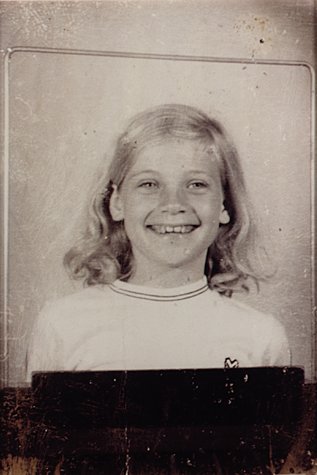 Harrell Fletcher and Jon Rubin, David’s wife Linda at age nine, 1998. SF MOMA Permanent collection
Harrell Fletcher and Jon Rubin, David’s wife Linda at age nine, 1998. SF MOMA Permanent collection
Design and Social Practice
To me, good design seeks to achieve a lot of the same things as social practice does. Exposing regular people to good work, exposing seemingly mundane truths to a mass audience. Design is art for the masses. Sure, a lot of design is for designers. But how interesting is that work? And a lot of design that is for the masses is commercial, is total crap, is selling deadly things like fizzy drinks or gasoline. But truly accessible design reaches the broadest possible audience without discriminating or favoring a particular set of individuals. It illuminates truths about humanity that were previously unapparent.
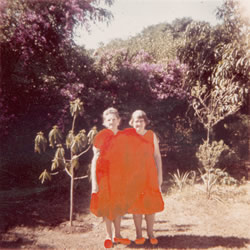
Untitled, Harrell Fletcher, 2005
I like that Harrell sees himself oftentimes as simply transcribing information. As an artist he’s turned the spotlight on the people he works with, illuminating their stories and giving them an audience. I see designers, who often work with someone else’s copy on someone else’s projects, as holding similar roles. Harrell Fletcher:
“A big part of my work is grunt work, so that somebody can get their words or their photographs or whatever it may be out there. I’ve always been very particular about transcription too; I think it’s crucial. I can turn somebody’s speech into something interesting by making sure that I include everything, or start, or stop, at a certain point, or whatever it takes.”
As designers, we are in a similar position where we can employ our skills to persuade, reveal, expose, narrate or reveal content as we see fit.
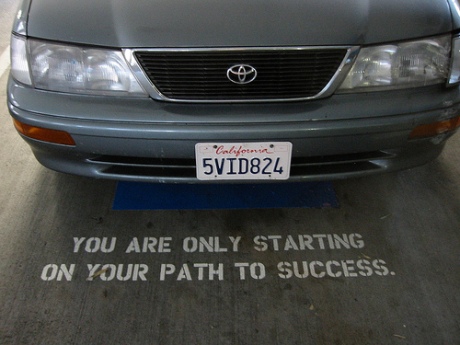 North Beach Parking Garage, Harrell Fletcher and Jon Rubin, 2002
North Beach Parking Garage, Harrell Fletcher and Jon Rubin, 2002
I think that some of Harrell’s approaches to his artmaking can be incredibly valuable to us as designers, especially a sentiment about interest. I think that in order for the work we make to be maximally effective, inspiring and genuine, we must be passionate about and interested in the work we’re doing. Here’s what Harrell says:
“And what is the best strategy for appearing interested? The answer is to sincerely be interested in fact nothing else will work. This is not difficult for me, because I actually think that people are interesting.”